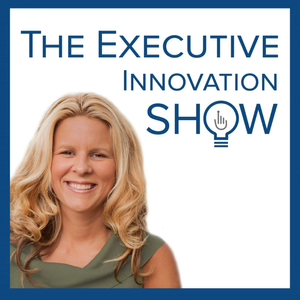
The Executive Innovation Show
Carrie Chitsey
All episodes
Best episodes
Top 10 The Executive Innovation Show Episodes
Goodpods has curated a list of the 10 best The Executive Innovation Show episodes, ranked by the number of listens and likes each episode have garnered from our listeners. If you are listening to The Executive Innovation Show for the first time, there's no better place to start than with one of these standout episodes. If you are a fan of the show, vote for your favorite The Executive Innovation Show episode by adding your comments to the episode page.
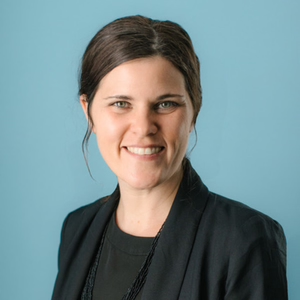
Establishing Hope in Child Poverty in the US (Children Incorporated)
The Executive Innovation Show
03/21/19 • 25 min
In this episode of The Executive Innovation Show Podcast, Carrie Chitsey speaks with Shelley Callahan about establishing hope in child poverty in the United States.
Shelley Callahan is the Director of Development with Children Incorporated. She is also the writer of the On the Road Series, which highlights their work around the world.
Listen in as we discuss topics such as:
- Hear about the work done by Children Incorporated and how they partner with schools, orphanages, homes and childcare centers to help children with basic needs. They work to provide food on weekends, clothes, shoes and school supplies.
- We talk about the importance of showing a child that someone cares for them and improving their self-worth.
- Learn why the volunteer coordinators are the critical component to both the children and the non-profit to reaching youth in need.
- Shelley discusses the “On the Road” series to paint the picture of different success stories of children and highlight the work that Children Incorporated is doing.
- Shelley and Carrie speak about the impact the opioid crisis is having on child family separation today. The US has seen a large increase in children being raised by grandparents, aunts, uncles and other family members, what financial constraints and health issues is this trickle effect causing?
- Hear about what’s next on the horizon for Children Incorporated in 2019.
To follow Children Incorporated and how they are helping children all over the globe.
Download the Youth Mental Health Infographic and learn more about Humans Helping Humans.
Support the show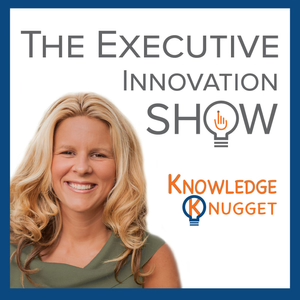
Knowledge Knugget: Telemental Health: 10 Benefits and Use Cases
The Executive Innovation Show
02/13/20 • 8 min
Read the Blog
Welcome to this week’s healthcare Knowledge Knugget! Today, we will be talking about the 10 Telemental Health Benefits and Use Cases. Watch the video to learn more about how people are using telemental health and some very specific uses cases?
Mental Health
How can telemental health reduce those no show rates? It allows you to look at somebody that's coming in for therapy sessions once a week, whatever it may be and allowing them for certain times and appointment times to be able to do that through video telehealth.
Senior Care
A lot of seniors are going through mental health issues and they don't know how to explain it. Being able to do video appointments in the comfort of their own home and talking to them about things like depression or anxiety from retiring or being in isolation.
Youth Mental Health
Attending an in-person youth mental health appointment is a double-edged sword. With telehealth technology and telemental technology being browser-based, the school doesn't have to buy any expensive hardware or software.
Foster Care
Children that are in foster care are on Medicaid and it's very hard given the guidelines of foster care for foster parents to be able to take off work or even get somebody to give the foster child a ride to mental health appointments.
Medicaid Access
The last one in this bucket of youth is Medicaid access. Normally it is very hard to get a Medicaid appointment for mental health. If you're a mental health professional with a private practice and you're not taking Medicaid, you should look at the reimbursement, you might reconsider and it can help for youth and population health and even seniors.
Rural Health
The next use case is rural health. There's a lot of shortage areas. And so reaching those rural areas where people are driving an hour and a half, two hours to appointments to rule in community hospitals for mental health, um, is as a big area.
Facilities Using Virtual Care
So a lot of your rural and community hospitals don't have enough mental health professionals on staff and they can't give people to live in those rural areas.
Psych Evaluations
There's a lot of shortage of being able to get that immediate psych eval, whether it's a treatment facility and it's an admission that you needed, whether it's a foster care system, whether it's a rural community hospital, there's a large shortage in psych.
Follow-up Appointments
Whether the patient is discharged from the hospital and you're putting it on the patient to then go find a mental health professional or your jotting down some names or giving a sheet to go get a mental health professional, there's a big breakage in that happening.
Treatment Facilities
All the telemental health that goes on in a substance abuse treatment facility daily, weekly, whether you're in 30, 60, 90-day rehab and you're getting discharged, you build this relationship with that mental health professional and now you're kind of out on your own.
Feel free to submit questions or be featured on the Knowledge Knugget. Subscribe to our YouTube, Vimeo, and the podcast channels to get your Knowledge Knugget on Thursdays.
Download our latest telemental white paper and listen to the healthcare podcasts where we talk about all the use cases for telehealth.

What Are Hospitals & Payers Role in Virtual Care? (Sutter Health | Aetna)
The Executive Innovation Show
09/24/19 • 26 min
Welcome to the Executive Innovation Show Podcast, brought to you by One Touch Telehealth. During this podcast hear host, Carrie Chitsey, talk with Steve Wigginton.
Steve Wigginton is the CEO of Sutter Health | Aetna in Northern California, a joint venture between the two parent companies. Wigginton is a respected leader with a proven track record of driving culture, growth, and innovation in the healthcare industry, having been CEO of Valence Health, Chief Development Officer of Evolent Health and founding CEO of Medley Health.
Listen to “What are Hospitals + Payers Role in Virtual Care?” as we discuss:
- Steve Wigginton talks with Carrie Chitsey about the 50-50 joint venture with Aetna and Sutter Health. Listen as Steve talks about how this joint venture can leverage the emerging capabilities that technology has, such as virtual care. He also talks about the benefits it has for providers, employers, and patients.
- How can health systems across America deliver a great patient experience that lowers costs and while improving patient outcomes? Steve talks about the advantages payers, employers and patients can receive by these sort of 50/50 joint ventures.
- Migrating to a value-based care model from a fee for service model, hear Steve give his reasoning as to why a fee for service model does not best serve the patients. Are health systems starting to realize that upfront investments in patients have long-term healthcare cost reduction? Are we there yet?
- Should digital healthcare innovation come from the payer, hospital or the provider?
- Hear Sutter Health | Aetna CEO talk about the hurdles a health system must face to reach a level of totality across the delivery system. From human capital management training and internal workflow, he explains there must be a maturation process to connect these virtual health capabilities across the board.
- One of the biggest problems in America’s healthcare system is rural healthcare. Steve Wigginton gives his top three things rural health community CEOs should be thinking about as 2020 approaches in regards to prioritizing virtual care for better patient outcomes.
- As always we ask Steve what are the top two healthcare-related things that keep him up at night. Besides teens, what are they?
Stay up to date with Steve Wigginton and Sutter Health | Aetna as they continue to bring innovation to healthcare.
How can your health systems provide better virtual care? Grab all your resources to learn how to impact patient outcomes, implement virtual care and patient experiences.
Support the show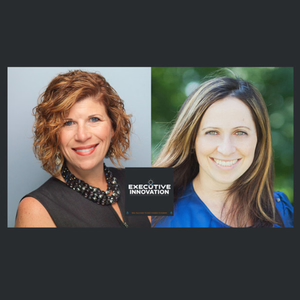
What Matters Most to Job Candidates in Selecting a Workplace (Assurance & EverythingBenefits)
The Executive Innovation Show
08/06/19 • 27 min
In this episode of the Executive Innovation Show Podcast, Carrie Chitsey speaks with human resources professionals Michele McDermott and Rachel Lyubovitzky about the most important benefits to employees
Michele McDermott, former Senior Vice President at Assurance, one of the largest and most awarded independent insurance brokerages in the U.S., consistently named a top place to work. At Assurance, Michele was responsible for maintaining the company’s “Best Place to Work” culture, driving the development of current and future leaders, and developing new programs that minimize risk and maximize health for the company’s employees.
Rachel Lyubovitzky is CEO and co-founder of EverythingBenefits, the leading provider of next-generation automated benefits technology that uncovers hidden costs, eliminates errors and helps keep companies compliant.
Listen in as we discuss topics surrounding selection criteria of employees and what they look for in a workplace.
- Named one of the “Best Places to Work”, Michele McDermott of Assurance talks about how they create a culture built for success and employee engagement. How do you create a place where people want to wake up every morning and come to work? Listen as Michele talks about how remote working is a big draw for the younger demographics, Millennials and Gen Z’s. Assurance recognizes that today’s employees want to work differently and are committed to employees having work-life balance. Listen to what makes Assurance one of the best jobs for millennials.
- What are some great recruiting strategies? A job description is often the first impression that a potential employee sees. Assurance’s job descriptions have a creative rockstar motif. Listen as we talk about how changing that job description can paint a better picture of your company’s culture. A job description doesn’t have to be a boring list of qualifications, how do you stand out from the clutter and speak to your ideal candidate culture?
- How can your company attract younger demographics from Millennials to Generation Z and what are they looking for in a career? Michele talks about the changes she has seen in the types of things Millennials want in a job. From community involvement to flexibility and mobility, hear what it takes to bring in top talent from these younger generations. Since the average tenure is now down to an average of two years, how do you retain them in a great company culture?
- Are you attracting talent? We talk with Rachel Lyubovitzky about the change in the type of benefits that Millennial employees are seeking. How can these new benefit types curve millennials job hopping? Hear how employees these days are interested in benefits such as pet insurance and tuition reimbursement. What benefits can you offer to attract top talent from this younger generation?
- Hear how the new employee onboarding process and questions from younger demographics are increasing the need for white glove HR support.
- With 75% of the workforce being Millennials in 2020 and Generation Z also stepping into the workforce for the first time, should you change your benefits package to accommodate them down the road? As a technology first-generation, how should the delivery, communication, and support migrate to more digital and video first communication?
Read more about Assurance & their 2019 Best Place to Work in Chicago recognition.
Keep up with Rachel Lyubovitzky and EverythingBenefits by visiting their website.
Download the eBook, "Reach & Recruit a Passive Front-Line Talent Pool"
Support the show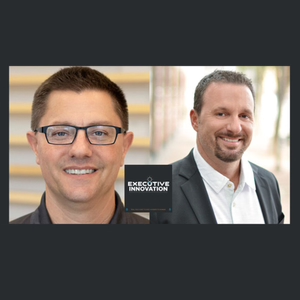
No Afterthought: Retention and Attrition (PhenomPeople & Sage Dental Management)
The Executive Innovation Show
08/20/19 • 29 min
In this episode of the Executive Innovation Show Podcast, Carrie Chitsey speaks with John Reaves Whitaker, VP of Talent Acquisition & Retention at Dental One Partners and Brad Goldoor, Chief People Officer of Phenom People.
Brad Goldoor is co-founder and Chief People Officer for Phenom People, where he oversees Phenom’s signature “not normal” hiring, onboarding, and employee engagement initiatives. He specializes in startups and has over 25 years of experience in channel sales, digital advertising, and People operations.
John Reeves Whitaker is the SVP & Chief People Officer for Sage Dental Management. He is a featured contributor on FistfulOfTalent and The HR Exchange Network & actively working on his next book, “We’re All Millennials.”
Listen as we discuss the following topics:
- We talk with Brad Goldoor about talent experience management and what it means to Phenom People to solve the candidate experience problem. How is Phenom People’s talent experience software much more than an ATS (applicant tracking system)?
- To prioritize retention and attrition, what does Phenom People do that is extremely special for new employees on their first day?
- What are the key factors that are driving high attrition rates within organizations? Carrie and Brad breakdown what they believe contribute to high attrition rates among employees. Hear why it starts with the recruitment process.
- How do you make sure your recruiters are looking past the fill rate? Phenom People measures their recruiters on employee engagement rather than fill rate. What are some of the 20 data points he uses? Listen to find out.
- For HR leaders, how do you get buy-in from the C-level to change the way your current Human Resources department operates?
- Listen to what problems and demands that are keeping Brad up at night. One of those issues is upskill training. He states “Are we providing an environment to help nurture people's skills and careers so that they have a path toward the future?”.
- Fill rate vs retention, which one should be the most important to your recruiters? We talk with John Reaves Whitaker about how he has abandoned fill rate metrics and looks to incentivize recruiters based on retention. He explains how the retention rate helped his HR department take ownership that helped the recruiting team recruit differently.
- In areas like healthcare where the unemployment rate is less than 1%, John talks about what moves you must make to find the right talent for the job. He suggests that by only targeting jobs boards and job ads, you aren’t doing enough. In today’s candidate-driven market, you have to be smarter.
- Is the role of the recruiter more digital marketing to reach a passive talent pool?
- As we continue to look past fill rate and build effective relationships to increase employee retention and attrition, John discusses some of the practices that he uses with his recruitment team to enhance the relationship with new employees.
- John gives his advice to other HR leaders on how not to make retention and attrition an afterthought with this awesome Texas expression, “You can’t cool down the room if the windows are still open”.
Keep up with Brad Goldoor at PhenomPeople.com and their journey in talent management experience.
With his new book coming soon, “We’re All Millennials”, John gives us a prelude of what to expect.
Download the White Paper mentioned in the podcast, "Reach & Recruit a Passive Front-Line Talent Pool"
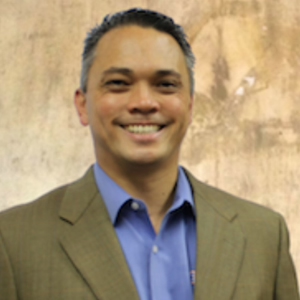
Concierge Medicine & Video Telemedicine with Dr. Tommy
The Executive Innovation Show
01/22/18 • 18 min
Host Carrie Chitsey Wells has on as a guest Dr. Tommy McElroy of Echelon Health and host of the Dr. Tommy Show.
Dr. Tommy is an expert in concierge medicine and new healthcare innovation for doctors. Hear Carrie ask him about why concierge medicine is on the rise and why it benefits both doctors and patients.
Some other topics that were discussed in the podcast:
- The In's and Out's of Concierge medicine and patient preferred communication trends and channels.
- How video telemedicine is on the rise, why it's helpful for doctors and customer convenience.
- What should doctors, practice groups, and hospitals be thinking about when implementing video telemedicine and video telehealth?
Check out Dr. Tommy's Podcast
To learn out more about Video Telemedicine
Support the show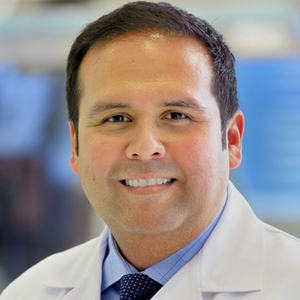
Dr. Michael Gonzalez, Houston ETHAN Program Ambulatory Video Telehealth
The Executive Innovation Show
01/10/18 • 28 min
Host Carrie Chitsey Wells has on the show guest Dr. Michael Gonzalez from the Houston Fire Department and one of the creators of the innovative ETHAN Program. The ETHAN (Emergency Telehealth and Navigation) is a community-based paramedicine approach that integrates the extensive use of mobile video health technology with traditional medical care.
The ETHAN program is being funded by the Texas 1115 Healthcare Transformation Waiver Program and began in late 2014. It has since morphed into one of the first video telehealth programs used by a city globally.
An overview of how the ETHAN program works:
- After a first responder arrives on scene, the crew assesses the patient to determine if they require emergency care or activates the ETHAN program.
- A tablet that is in every fire/EMS truck is then used to connect the patient with an emergency physician via HIPAA compliant video conferencing technology.
- The physician then determines if the patient should be referred to a community clinic via taxi, referred to the ED via taxi, transferred by ambulance to ED, or referred to their own doctor.
Listen to Carrie discuss some of the following topics with Dr. Michael Gonzalez:
- They talk through the numbers, ROI and how 80% of the outcomes did NOT require an ambulance.
- Where is the future of 911, 311, and natural disaster video telehealth headed? Will the future of callers/patients in non-life threatening situations connect with their own smartphones through video telehealth without having to dispatch an ambulance or fire truck?
- What are the lessons learned to share with other cities and municipalities?
A diagram of how the ETHAN program works, the numbers, savings, ROI can be found in the Infographic here.
Support the show
Is Video Banking Affordable?
The Executive Innovation Show
02/03/22 • 4 min
Today, we're gonna be talking about a question we get all the time — is video banking affordable?
So the one bucket I want to break down on is video banking and the ROI. We have a great ROI calculator that you can click on here in the show notes and see your actual video banking ROI for your individual bank or credit union. But really the ROI comes from several different buckets.
It comes from, on average, a 20% efficiency in your workforce. It comes on the increased conversion rate on your website, traffic, reducing application abandonment rate, increasing the conversion rate of new customers. Then it also comes from the relationship management side and increasing wallet share with existing customers.
The second bucket I wanna talk about is staff optimization. A lot of banks and credit unions have reduced their staff in certain locations with centralized hubs, with smaller micro branches and the ability whether somebody comes into a physical branch and you only have, you know, one business banker in that location.
They're tied up for the next 20 to 30 minutes, having a cove or cubbie where you have video banking to connect that person to another business banker in a different location really allows you to optimize that staff across locations.
That really goes into number three, as well as the physical branch, and real estate is not as important in the banking community anymore. Expanding your market share without spending on average 2 million per physical branch location with video banking.
It really allows you to expand into markets where you do not have a physical branch or expand into markets that are outside of that five to a seven-mile radius of driving distance. So it allows you to acquire new customers and hire folks in a centralized hub, in a centralized location to support those markets.
The last one that I wanna talk about is: is video baking affordable? Comparing it to ITMs. And so as we look at interactive teller machines and the average cost being $80,000 per hardwired ITM, that is only good. If somebody is driving to that existing branch location, and if they're an existing customer, it doesn't support new customer acquisition. And in comparison to one ITM at $80,000, the average video banking customer is spending about $1,500 a month or $18,000 a year.
That is not tied to a physical location. So if we compare the 80,000 to 18,000 and the average span has a minimum of three videos ITMs, we're really comparing 18,000 to $240,000. So food for thought on answering the question is video baking affordable. You could click more to really look at our optimizing branch workforce white paper, an infographic, and really walk through that, play around with the ROI calculator.
As you're looking at your budgets for 2022, asking "Is Video Banking Affordable?" make sure to schedule a demo today to see for yourself.
Support the show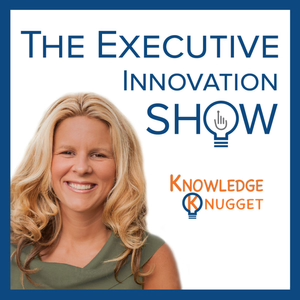
Knowledge Knugget: Why are Banks Scrambling to Video Banking?
The Executive Innovation Show
12/17/20 • 7 min
https://otvideochat.com/video-banking-covid-19
During today's topic, Carrie Chitsey talks about why banks and credit unions are scrambling to video banking.
As we are aware, with COVID and with shutdowns, a lot of branches have been either completely closed in certain states or have started to open back up but with limited hours or drive-thru only. This has shaken up the banking industry on how to do normal business, and how to have employees work virtually in a secure manner. Banks typically never had employees working from home.
There have been a lot of challenges, both on the operational side, as well as the marketing side of how do you acquire customers in the middle of a pandemic. How do you get them to come into a branch to open up an account? We're going to walk through some of those things today and talk about how you solve them.
“What's the future of the physical branch?”
Banks right now are scrambling on how to put that playbook in place of this new normal. The first thing to talk about is “What's the future of the physical branch?”. That's a big question that we get, and there's a lot of banks that have spent a significant amount of money on creating these open branch pods, taking down the glass, taking down the walls, really trying to have more intimate conversations with customers and make them feel more at home.
As we look at this new world where banks have had to on a dime, adapt to this new world of how do we get computers in people's homes for our employees to work? How do we hire remotely? There are all these challenges going on, we have a virtual playbook on “Banking Beyond Four Walls” where we cover a lot of this.
Hybrid Banking Model - Acquiring Customers
What does the new normal look like? It's a hybrid model. There's going to be people that come in. Most banks are holding off on branch expansion for physical locations and rethinking that.
How do you acquire customers in a pandemic? You do digital marketing. As you look at acquiring customers, if you're doing digital marketing, the biggest issue has been the conversion rate. Getting people to look at an ad, go to your website, and then making them fill out a physical application in a location in a branch, or bringing you a physical driver's license.
If you look at implementing a video banking solution, you're able to still service customers. You have your relationship managers, your business bankers, private clients, wealth management, those types of folks still having that face-to-face conversation through video with customers. This allows you to increase that wallet share with those customers because they're not just banking with you, they're banking with others. You must be proactively reaching out to your customer base and sending them to your website to have a conversation through a video banking platform. Or they could be increasing their business with somebody else or remembering who reached out during that pandemic.
Through video banking, you can switch some of these levers and move that needle on the servicing and acquisition side.
Download the playbook and stay tuned to our weekly episodes of the Knowledge Knugget to learn more best practices and tips on how to incorporate video banking and digital transformation into your bank or credit union.
Listen to the video banking podcast and subscribe to the podcast and rate us! Have a Knowledge Knugget idea? Reach out and submit today.
Support the show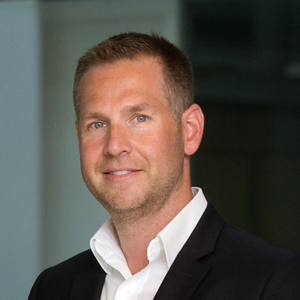
Recruiting + Reaching Today’s Job Candidate with Joseph McElmeel (SymbaSync)
The Executive Innovation Show
12/04/18 • 35 min
In this episode of the Executive Innovation Show, host Carrie Chitsey Wells talks with Joseph McElmeel. McElmeel is the co-Founder and CEO of SymbaSync. SymbaSync is the 2017 & 2018 Winners of the U.K.’s SME awards for Best Talent Sourcing software and Most Innovative Recruitment platform.
Listen for topics discussed on this podcast such as:
- Comparing the hiring wants of three generations. Millennials, Baby Boomers & Generation Z. Have the job candidate wants vs. needs changed?
- Job specialization is a growing trend among younger generations to avoid student debt. Is it helping or hurting the job market?
- Can the candidates first impression improve with adding back the recruiter “human touch”?
- How do HR executives break the barrier of technology?
- Find out how much a bad hire really costs your organization.
- Dealing with Millennial/ Gen Z “ghosting”. Can you minimize future ghosters by getting candidate feedback sooner?
Learn more about SymbaSync and grab your FREE trial.
Download a FREE White Paper, “Recruiting in a Candidate Driven Market” to learn more tips, tricks and tools for your hiring plans in 2019.
Support the showShow more best episodes

Show more best episodes
FAQ
How many episodes does The Executive Innovation Show have?
The Executive Innovation Show currently has 126 episodes available.
What topics does The Executive Innovation Show cover?
The podcast is about Health & Fitness, Management, Digital Health, Mental Health, Medicine, Podcasts, Business and Healthcare.
What is the most popular episode on The Executive Innovation Show?
The episode title 'Driving Loans Through Video Banking' is the most popular.
What is the average episode length on The Executive Innovation Show?
The average episode length on The Executive Innovation Show is 24 minutes.
How often are episodes of The Executive Innovation Show released?
Episodes of The Executive Innovation Show are typically released every 7 days.
When was the first episode of The Executive Innovation Show?
The first episode of The Executive Innovation Show was released on Feb 8, 2017.
Show more FAQ

Show more FAQ